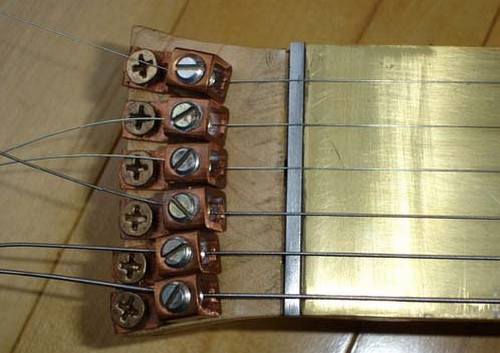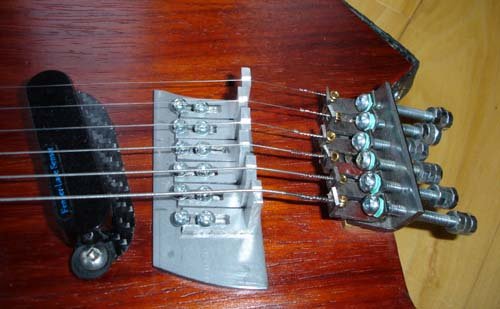A DIY Headless Guitar Tuning System
With necessity the mother of invention, the difficulty and cost in obtaining headless guitar parts has led to a number of ingenious solutions including those seen in Make Your Own Headless Guitar Tuners! and Henry Olsen’s MaSh Acoustic Guitar.
This latest example is a DIY headless guitar tuning system recently seen on this fretless baritone guitar.
Headpiece
The “headpiece” string retainer is ingeniously simple consisting of copper connector lugs and stainless steel set screws from a local electrical supply store.

Bridge
The bridge is made up of a 35mm x 3mm x 85mm piece of flat steel with 6-25mm aluminum angle irons to support the strings.
Intonation is set by sliding the grooved angle bracket between the two positioning screws that are fastened to the flat bridge plate.
String height is determined by the depth of the groove on the top of the aluminum angle iron and was accomplished with a feeler gauge to determine string height at the 12th fret.

Tailpiece
Finally, the tail piece consists of a 3mm steel angle iron (19mmx 19mm) with six holes drilled through for the tuning bolts. U channels hold the strings in place and two green plastic washers keep the u channel from rotating with the bolt.
For more on this headless tuning solution and the baritone fretless guitar, see Unfretted.com’s Building a Baritone Fretless.
Neat, I like the idea for the headpiece. Better than just leaving a capo on the neck! 😉
It’s also a nice solution because it’s so easily adaptable to a conventional neck. Lop off the headstock, leave enough for the string retainers and you have a headless guitar neck. 🙂
What strikes me when opening up the first page of this site is that a couple of pictures are shown on this ver y own DIY guitar project, and its saddles, bridges, and tuners. Then just one page down, the very nice and posh ETS bridges are displayed and pops up at you.
Such a striking contrast!
I wonder if not these homemade string retainers, bridges, tuners are downright hazardous to you fingers, and dangeroulsy close to cutting yourself with it/on them.
Although, I have no doubt that their function is at least just as good as the ETS ones, I found the lumping together of them, which surely is a mere coincidence, are a bit ill-fated. I can’t help but giggling a bit on this one. I am not intending to being rude and mean, if one have the interest of doing everything yourself (true DIY project) it will end up looking like that.
The solutions will have to turn out a bridge and tuner system looking like this. The amount of work and commitment must be revered at. If it does the job who care what it looks like? It’s far cheaper than the ETS for sure.
But is the hardware on this DIY project, really that ergonomic, looking like it would harm your fingers? Or make damages and scratches to your skin while changing strings or doing intonation?
What I mean by all this is, that this raises a new question. How much in “ergonomics” are geared towards metal hardware, and setting up, changing strings and tuning, even electronics? The “ergonomic” thing has so far been aimed at the playing positions and the overall appearance of the instrument. And to buck RSI. Let’s say, just an example:
I’ve always wanted a solution to be able to swap out pickups on a guitar very easily and much easier than it is today. Not requiring any new resoldering, or even, slacking of strings. Also, I find the intonation bit on all Steinberger bridges a little on the easy, and shaky side. You have to clamp all string seats from the side. While you’re loosening them, you run the risk of whacking the ones you’ve already intonated out of tune anyway. On a regular Gibson Tune-O-matic bridge, you can adjust each strings without risking the other one’s to go out.
Granted, these things are only done just once in a while, but anyway. The Floyd Rose systems are one of the most un-ergonomic and unwieldly systems I’ve ever came across. So this is just an example for your thoughts. Floyd Rose sure does it’s job, but it’s anything BUT ergonomic.
To each their own. I find the use of the electrical crimping posts for string locks to be elegant. The clamping screws are even beveled.
As usual, a very thoughtful comment, Mats.
My main purpose in featuring DIY tuning solutions is to encourage folks to consider the possibility of alternatives. Some of them will be on the primitive side while others will be more polished.
This one definitely runs on the rough side of things but that’s not the case with all DIY solutions. For example, Make Your Own Headless Guitar Tuners ! shows several interesting variations by Jeff Turpin that show varying approaches.
You’re absolutely right that ergonomics as a subject is far more inclusive than what we’ve largely focused on.
I guess the question is how far do we want to venture in those directions given the focus of this site? Right now, the focus has been on ergonomic designs, making those ergonomic designs and addressing RSI issues. Would we be expanding the content in a positive direction by delving further into other details of ergonomic design or would we be diluting the site’s focus?
I’m not sure what the answer is but I’d enjoy hearing what others think.
how do you tune it i dont understand how you can accurately
It’s tuned using the bolts at the bridge. If you look at the last picture, you’ll see the ball end of the string passes through the end of the roughly U shaped angle iron. A bolt passes through the other end. Turning the bolt moves the angle iron thus tuning the whole thing. The concept is the same as you see in the Steinberger headless bridge although its implemented differently.
i under stand that thats how its done but it doesent seem like you would be able to tighten up the strings to “tuned” the strings would be loose when you put them on and the bolt doesent seem long enough to tighten it up enough. when i tune my guitar with standard tuneing keys it goes aruond the peg like 5 times atleast that adds up to at least 2 inches! And thats before the strings strech! i guess my question is why dont you need to use bolts like 8″ long?
Imagine bicycle brake cable adjustors, they are this long or even shorter, and I have succesfully used them for guitar string tuners. It doesn’t take as much as you might think. Gearing is also an issue in imagining the mechanical process of tuning the string to pitch.